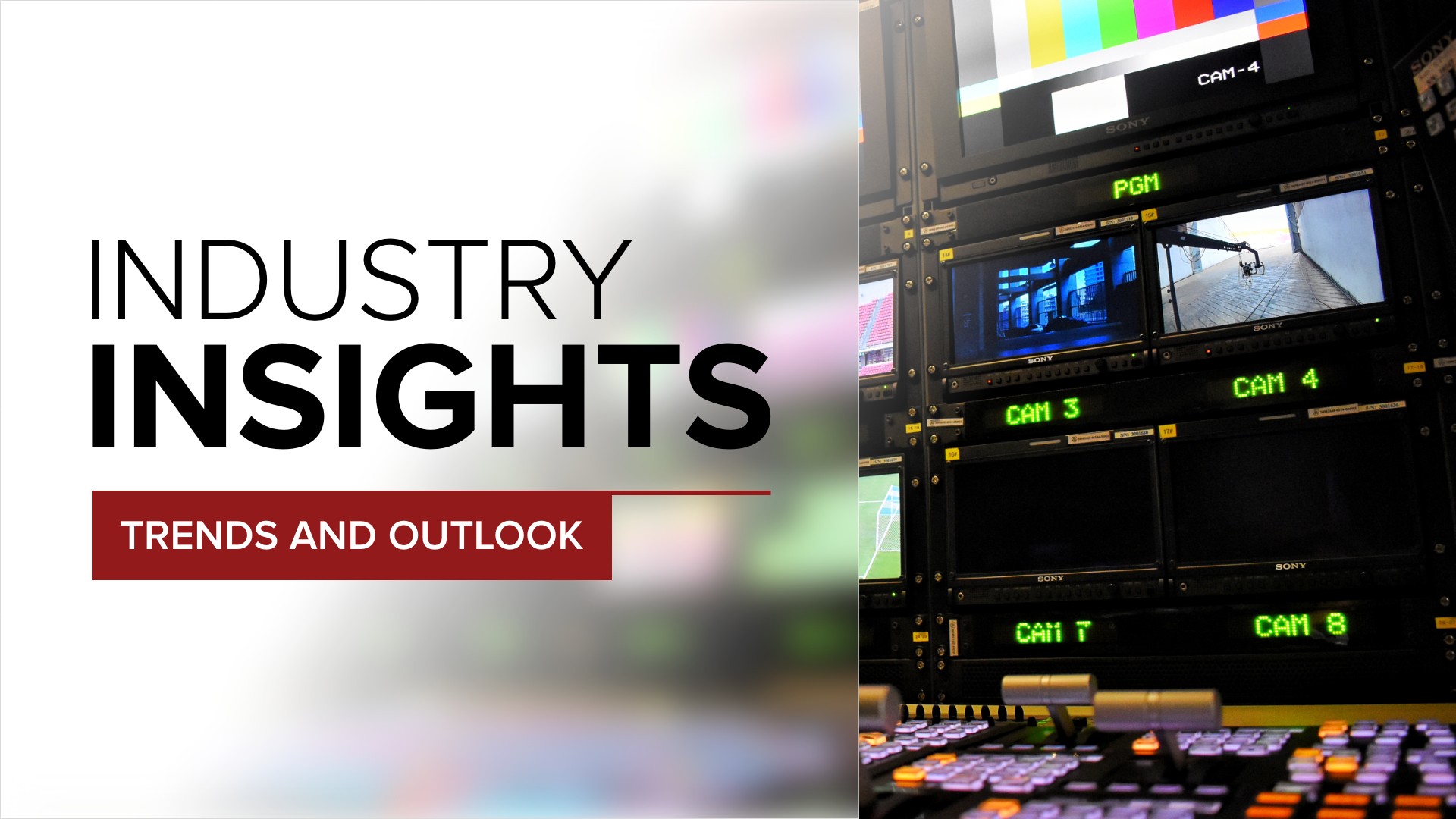Industry Insights: 2022 outlook from the broadcast production sector

Subscribe to NCS for the latest news, project case studies and product announcements in broadcast technology, creative design and engineering delivered to your inbox.
Early this year, we spoke with broadcast professionals from across the industry, asking for their insights into 2022.
This Industry Insights roundtable features answers from those whose companies supply the production part of the broadcast pipeline.
Explore the other parts of this roundtable:
- Acquisition including Cameras, Transmission, Audio and Studio Gear
- Production including Creative Services, Graphics and XR Solutions
- Infrastructure including Hardware and Software Infrastructure
- Distribution & Delivery including Automation, Playout, Streaming, File Transfer and Monitoring
What is your 2022 outlook?
Ben Davenport, VP of global marketing, Pixotope: We’re excited about the year ahead. Despite challenging conditions, we’ve sustained good growth over 2020 and 2021, and see that our solutions for Virtual Production are meeting the needs of the market well.
Paul Babb, CMO, Maxon: In 2022 we will continue to emphasize bringing the very best creative tools to digital artists under the Maxon One platform. Recent additions to our product portfolio like ZBrush, enable us to delight creative artists with an ever expanding and powerful toolset to help fulfill their creative visions.
Graham Sharp, CEO, Broadcast Pix: I would say uncertain. I think we will have a slow start to the new year, with businesses continuing to preserve cash.
Neil Maycock, CMO, Grass Valley: Last year, we reinvigorated the Grass Valley brand identity to reinforce our core focus on live media. Looking into 2022, we’re committed to bringing live to the cloud and enabling our customers to transition to new business models to align with evolving consumption patterns.
Gerhard Lang, CTO, Vizrt: Looking toward 2022 and beyond, a primary focus for us are cloud solutions. We want to create cloud-first workflows for our customers to distribute and scale content. Another focus is developing a unified workflow for consistent content across various platforms. End users need to adapt and version the graphics and composition of the video for a cohesive story depending on the platform.
Dave Van Hoy, president, Advanced Systems Group: While we are clearly in unpredictable times, based on our activity last year, our outlook for this year is very positive. Our system integration business has expanded beyond pre-pandemic levels as our clients catch up projects that were delayed or changed. The unexpected surprise from 2021 was the continued growth of our managed services business where we help our clients operate and maintain their facilities.
Raúl Alba, director of solutions marketing for media and cloud, Avid: We worked closely with our customers throughout the pandemic and that has helped us to reshape and reprioritize the innovation that is needed in 2022 and beyond to help keep productions moving. Innovation will continue to drive creative approaches for remote working and collaboration. The important thing is that none of us stand still.
David Bauman, creative director, Stephen Arnold Music: We’re in a period where creativity in media and marketing is at an all-time high. These days, when I see commercials, I actually enjoy watching most of them. The concepts are great, the storylines are fresh and creative, and they really pop visually and sonically. It’s an exciting time to be involved in sound and music because the guardrails are off.
BK Johannessen, Unreal Engine business director for broadcast, Epic Games: 2022 will undoubtedly be an exciting year. Unreal Engine has been embraced by broadcasters worldwide as the preferred graphics solution for high-quality virtual production. The ecosystem of talent available is growing, and with the extreme increase in demand there is a significant need for additional talent with broadcast and Unreal Engine expertise.
Stephen Brand, president & CEO, IntraCom Systems: 2022 will see continued interest in cloud SaaS-based solutions that extend studio operations to remote workflows. The medical experts say that we need to learn to live with COVID; cloud solutions that run on standard computers and mobile devices will provide the flexibility the industry needs to adapt.
What trends are you watching in 2022?
Ben Davenport: Virtual production really proved its value in 2021. We saw some amazing viewer engagement with AR elements used by the Carolina Panthers and Houston Texans, not to mention creative advertising of Halo during the Oregon Ducks game in December. We also saw mixed reality come to the fore with shows like Alter Ego putting avatars front and center and not forgetting the growing number of productions using XR and virtual sets.
Paul Babb: We have to focus on today’s realities: how we can improve and enhance remote production, remote working, remote learning, remote gathering. For the foreseeable future, this is the world in which we have to maneuver. We have to find ways to improve our customers’ remote pipelines. We have to explore ways to make our virtual events more useful and engaging.
Graham Sharp: The work from home and remote meeting trends are key drivers for the streaming side of our business; however, I fear we have seen the bulk of the new investment in streaming that the virus brought and we were looking for our traditional markets to rebound. Hence it could be an uncertain year.
Neil Maycock: The 2022 live sports agenda is packed with pivotal events like the Beijing Winter Olympics and the FIFA World Cup in Qatar later this year. But companies are now thinking differently about how they reach audiences with premium live content across platforms — and how they can do this at scale while maintaining high-quality production values. A more flexible, cloud-based approach is giving media organizations greater agility and elasticity; this is critical in a market that’s in constant evolution.
Gerhard Lang: I expect a shift to adaptive storytelling for television producers and broadcasters. Being the first to air is increasingly important to engage audiences, especially in breaking news and critical communication situations. What will also happen is a continued shift to use the cloud. Bandwidth is a production factor that is continually growing and quickly outperforming other capabilities. This will continue to advance the move toward production, especially live production, in the cloud.
Dave Van Hoy: We are heavily involved in developing the cloud infrastructure for live production in order to be prepared as our clients experiment and migrate. It’s becoming the platform within which all manufacturer’s products need to co-exist. We have a team of cloud technology experts and created the cloud-based Virtual Production Control Room for real-time production of live events to meet this increasing need.
Raúl Alba: In addition to remote working, artificial intelligence and machine learning will continue to be a hot trend in 2022. From the automation of various functions like transcripts, logging, color correction, semantic text and image search, and string-out creation available on premises or in the cloud, production can take advantage of AI and ML across the production pipeline.
David Bauman: Sonic branding continues to become a greater point of emphasis in media. A sonic brand is more than just a mnemonic or audio logo; it’s a holistic sonic environment, a way for a company to express its identity and values in everything it does, and a way to elevate its emotional connection with its audience. Once associated with Fortune 500 companies, sonic branding is now being used by companies of all types and sizes.
BK Johannessen: We are super excited about the next generation of Unreal Engine which will be officially released in 2022 and enable content creators in all industries to push the boundaries of realism to the next level. Combine this with fast growing libraries, such as Quixel Bridge, SketchFab and the Unreal Engine Marketplace, which give content creators access to high-end 3D content, the effort and cost of building amazing experiences is getting lower and lower.
Stephen Brand: Interest in the Metaverse. Since Facebook rebranded to Meta, many others including Apple and Microsoft have announced big plans in the space. Virtual and augmented reality have enormous potential to recreate studio capabilities for a remote workforce.
Any lasting lessons from 2021 to consider?
Ben Davenport: There is a skills shortage when it comes to virtual production. That is to say, while there are a lot of hugely talented people out there running virtual productions, there are nowhere near enough of them. One of our big focuses in 2022 will be working with educators, our partners and even our competitors to try to address that problem both for the short and longer-term.
Paul Babb: You can’t fake community — it’s one of the hardest things about not attending trade shows. You have to go that extra mile to show your users and colleagues that they’re still supported and valued.
Graham Sharp: It’s not over until it’s over. Businesses are fatigued and many of the smaller ones cash strapped.
Neil Maycock: 2021 was a year of acceptance of cloud as an agent of digital transformation, and this year we’ll see greater cloud advocacy as media companies accelerate their digital transformation journeys, realize the benefits of true cloud elasticity, and shout from the rooftops about it.
Gerhard Lang: Adaptation, flexibility, and speed. There are several initiatives that have been triggered by the increasing demand for remote productions. Remote production demand will continue in 2022. We’ve also been able to utilize AR technology in remote productions to teleport interview partners into studios. Bringing interviewees into a virtual environment humanizes the experience and offers a more natural, relaxed conversation versus a Zoom or Microsoft Teams meeting on air.
Dave Van Hoy: There are no industry standards for systems integration in the cloud today. Hyperscalers are the new masters of communication protocol. The magic of being an SI has always been about being overall vision and glue between vendors. That continues but with a far different model. SI’s will play an important role in creating interfaces that fill in any gaps in software and hardware.
Raúl Alba: The rate of innovation we’ve seen across the industry over the past year was previously unimaginable. It’s been highly encouraging, and our biggest hope is that it continues to drive changes that provide more efficiency and scalability in media operations. Cloud-based production, IP content contribution, mobile workflows in news and sports are among some of the very promising technological tracks where experimentation and uptake will accelerate from 2021 into 2022.
Chad Cook, VP of creative services, Stephen Arnold Music: We’ve all been stuck at home and movies, television shows, games and other forms of entertainment have kept us sane while we have been unable to travel, or go to the live events, festivals, etc. We’ve not only been watching more, we’ve also come to expect better, including in terms of sound and picture quality.
BK Johannessen: The adoption of cloud as a viable production infrastructure for live broadcasts is on the rise. The pandemic gave us no choice but to explore this alternative, and with both the lessons learned over the past two years and the benefits that broadcasters now can see, it will gain even more momentum. That said, there is still a significant lack of knowledge about how to use cloud within the broadcast industry.
Stephen Brand: Don’t put off implementing remote work contingencies until tomorrow. A lot of broadcasters were put in difficult situations when physical plants were swiftly closed due to COVID.
How is the continued supply chain disruption impacting your business, if at all?
Ben Davenport: We offer a software platform so the direct impact isn’t necessarily immediately obvious but, of course, our software runs on CPUs and GPUs and shortages of both certainly impact our customers.
Graham Sharp: We are quite fortunate in that we mainly use consumer off-the-shelf hardware, and between the two or three specifications of motherboards, chassis, and video cards that we use, we have managed to obtain what we need.
Neil Maycock: Vendors need to have an open dialogue with customers to address supply chain issues. Like many other technology companies, we’ve experienced longer lead times from suppliers over the past year and have had to adapt to overcome those challenges. We’ve been creative in obtaining supply and have always ensured we can service our customers.
Dave Van Hoy: We’ve become more actively involved in helping our partners — from the vendor and customer side — in getting what they need in the quickest possible timeframe. No one is surprised by supply chain delays any longer, but we’re helping our customers manage the process.
Chad Cook: While supply chain issues have had no direct impact on us, they have affected some of our clients, especially those abroad. Some media companies have had trouble acquiring certain types of technology or even certain materials for set updates and redesigns. When those issues become acute, they can cause downstream adjustments to creative branding, marketing and advertising solutions. In our experience, that has resulted in projects that are fewer in number, but larger in scope.
BK Johannessen: Several of the hardware manufacturers who provide components required for broadcast production using Unreal Engine – such as SDI video IO, GPUs, media servers, and image processors – have seen a shortage of parts. This has created long lead times for customers who now need to place hardware orders much earlier in the process in order to meet deadlines, and it also means that decisions on hardware need to be made even earlier than before.
Stephen Brand: We provide a pure cloud SasS solution that works over standard PCs, Macs, iOS, and Android devices, so we weren’t impacted very much at all.
What is your outlook on trade shows for the year ahead?
Ben Davenport: On the one hand, it is very clear that, as an industry, we’re itching to get together and meet each other in person again. At the same time, the industry has changed a great deal. There are many individuals, vendors and end users that, with what will have been a 3-year hiatus, have never attended a NAB or and IBC. Equally, the world has changed and there are significant question marks over whether it is socially or environmentally responsible to have tens of thousands of people fly into a location for a few days for events.
Paul Babb: We’re optimistic that we’ll be able to gather again in all the usual places — but if we’ve learned anything from the past two years it’s that it is very challenging to predict what will happen. We’re eager to return to visiting customers, hosting user groups, sponsoring live events and attending in-person trade shows as soon as it is safe to do so.
Graham Sharp: They are still a critical part of our marketing plan, an opportunity to meet people face to face, for meetings, demos, and opportunities to progress sales, but they will never return to the pre-pandemic levels of spending. We, like most businesses, have discovered alternative, more cost-effective ways of connecting with our customers and creating leads.
Neil Maycock: It’s fair to say there was universal disappointment at IBC and NAB being forced to cancel last year, and I think our market is looking forward to hopefully being back together on the tradeshow trail in 2022. We see live trade shows as a core element of our global industry engagement. However, we’ve also adapted to staging virtual events throughout the year and amplifying our digital presence.
Chad Cook: We expect most trade shows will continue with virtual or hybrid formats this year, yet remain flexible to react quickly to health and market conditions. While we miss seeing our clients and colleagues in person and some of the in-person events we host, we recognize it may be a while before things return to normal.
BK Johannessen: We no longer have the same need for the big product updates and presentations from trade shows, but more than ever we have the need to build relationships and trust between customers and vendors. This is hard to do over Teams and Zoom meetings, and trade shows offer a relatively efficient way to establish personal connections and start conversations.
Stephen Brand: I think we will see a continued move towards virtual trade shows. This is another area where I see the Metaverse being impactful.
Subscribe to NCS for the latest news, project case studies and product announcements in broadcast technology, creative design and engineering delivered to your inbox.








tags
Advanced Systems Group, avid, Ben Davenport, BK Johannessen, Broadcast Pix, Chad Cook, Dave Van Hoy, David Bauman, Epic Games, Epic Games Unreal Engine, Gerhard Lang, Graham Sharp, Grass Valley, intracom systems, maxon, Neil Maycock, Paul Babb, Pixotope, Raúl Alba, Stephen Arnold Music, Stephen Brand, Vizrt
categories
Augmented Reality, Virtual Production and Virtual Sets, Broadcast Engineering, Broadcast Equipment, Featured, Industry Insights, IP Based Production, Virtual Sets, Voices